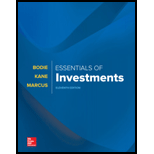
Concept explainers
Now suppose the investor in Problem
a. Recalculate the dollar-denominated returns for each scenario.
b. What happens to the standard deviation of the dollar-denominated return?
Compare it to both its old value and the standard deviation of the pound-denominated return.
(a)
To calculate:
The rates of return in dollar-denominated in different scenarios including a forward sale by the investor of
Introduction:
The dollar-denominated return is the return earned by the U.S. investor by investing a particular amount in foreign currency.
Answer to Problem 5PS
Below table highlights the values:
| Per share price (£) | Dollar-Denominated Return (%) |
| £ |
|
| £ |
|
| £ |
Explanation of Solution
Given:
Let's calculate the dollar-denominated return and for that, the following formula is used:
By using the above formula, Dollar-denominated return is computed as follows:
| Per share price (£) | Dollar-Denominated Return (%) |
(b)
To calculate:
Ascertain the standard deviation of the dollar-denominated return.
Introduction:
Standard deviation is a measure to calculate the deviation from the mean which is also called as a measure of dispersion. It helps in analyzing the performance of the fund.
Answer to Problem 5PS
The standard deviation for the dollar-denominated return is
Explanation of Solution
Given:
The table showing outcomes:
| Per share price (£) | Dollar-Denominated Return (%) |
| £ |
|
| £ |
|
| £ |
For calculating the standard deviation, the following formula is to be used:
For computing standard deviation of dollar-denominated return, following calculation is needed:
| Per share price (£) | Probability | Dollar-Denominated Return (%) | |
|
|
| £ |
|
||||
| £ |
|||||
| £ |
|
||||
| |
Variance computed as above is
Now, for standard deviation of dollar-denominated return at the rate of
Want to see more full solutions like this?
Chapter 19 Solutions
Essentials Of Investments
- I need help with this situation and financial accounting questionarrow_forwardRemaining Time: 50 minutes, 26 seconds. * Question Completion Status: A Moving to the next question prevents changes to this answer. Question 9 Question 9 of 20 5 points Save Answer A currency speculator wants to speculate on the future movements of the €. The speculator expects the € to appreciate in the near future and decides to concentrate on the nearby contract. The broker requires a 2% Initial Margin (IM) and the Maintenance Margin (MM) is 75% of IM. Following € Futures quotes are currently available from the Chicago Mercantile Exchange (CME). Euro (CME)- €125,000; $/€ Open High Low Settle Change Open Interest June 1.2216 1.2276 1.2175 1.2259 -0.0018 Sept 1.2229 1.2288 1.2189 1.2269 0.0018 255,420 19,335 In addition to the information provided above, consider the following CME quotes that are available at the end of day one's trading: Euro (CME) - €125,000; $/€ Open High Low June 1.2216 Sept 1.2229 1.2276 1.2288 Settle Change Open Interest 1.2175 1.2176 -0.0083 255,420 1.2189…arrow_forwardI need help with this problem and financial accounting questionarrow_forward
 Essentials Of InvestmentsFinanceISBN:9781260013924Author:Bodie, Zvi, Kane, Alex, MARCUS, Alan J.Publisher:Mcgraw-hill Education,
Essentials Of InvestmentsFinanceISBN:9781260013924Author:Bodie, Zvi, Kane, Alex, MARCUS, Alan J.Publisher:Mcgraw-hill Education,

 Foundations Of FinanceFinanceISBN:9780134897264Author:KEOWN, Arthur J., Martin, John D., PETTY, J. WilliamPublisher:Pearson,
Foundations Of FinanceFinanceISBN:9780134897264Author:KEOWN, Arthur J., Martin, John D., PETTY, J. WilliamPublisher:Pearson, Fundamentals of Financial Management (MindTap Cou...FinanceISBN:9781337395250Author:Eugene F. Brigham, Joel F. HoustonPublisher:Cengage Learning
Fundamentals of Financial Management (MindTap Cou...FinanceISBN:9781337395250Author:Eugene F. Brigham, Joel F. HoustonPublisher:Cengage Learning Corporate Finance (The Mcgraw-hill/Irwin Series i...FinanceISBN:9780077861759Author:Stephen A. Ross Franco Modigliani Professor of Financial Economics Professor, Randolph W Westerfield Robert R. Dockson Deans Chair in Bus. Admin., Jeffrey Jaffe, Bradford D Jordan ProfessorPublisher:McGraw-Hill Education
Corporate Finance (The Mcgraw-hill/Irwin Series i...FinanceISBN:9780077861759Author:Stephen A. Ross Franco Modigliani Professor of Financial Economics Professor, Randolph W Westerfield Robert R. Dockson Deans Chair in Bus. Admin., Jeffrey Jaffe, Bradford D Jordan ProfessorPublisher:McGraw-Hill Education





